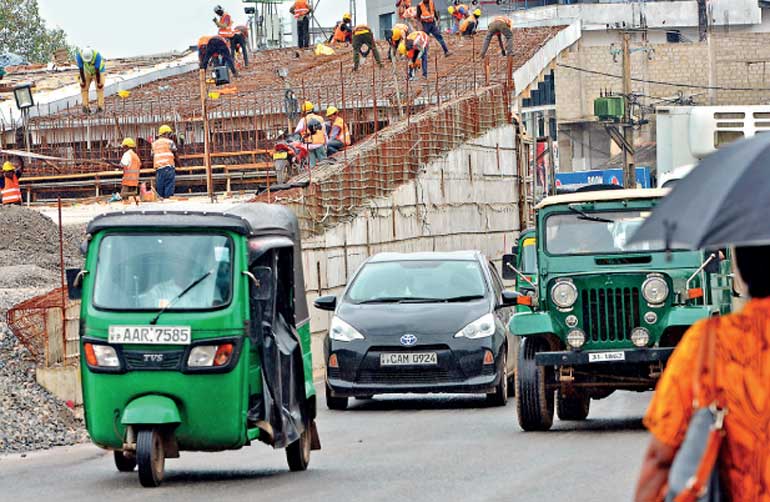Friday Feb 07, 2025
Friday Feb 07, 2025
Saturday, 6 November 2021 00:05 - - {{hitsCtrl.values.hits}}

High road crash fatality and injury rates on Sri Lanka’s roads are undermining the economic growth and progress made over the past decade on reducing poverty and boosting prosperity – Pic by Shehan Gunasekara
Priyantha Fernando* (34) was heading home after a typical day’s work when his motorcycle crashed into a lorry. His wife and two children saw their lives changed instantly when they lost the family’s sole breadwinner. Unfortunately, this tragic and unnecessary loss of life is all too common in Sri Lanka.
Available data shows an average of 38,000 crashes annually in Sri Lanka resulting in around 3,000 deaths and 8,000 serious injuries. The estimated annual road crash deaths per capita is the highest among its immediate neighbours in South Asia and five times that of the best performing countries in the world.
High road crash fatality and injury rates on Sri Lanka’s roads are undermining the economic growth and progress made over the past decade on reducing poverty and boosting prosperity. Over two-thirds of road crash victims are productive, working age adults between 15-64 years of age.
This situation is exacerbated by the rapid growth in vehicle ownership – 67% between 2011 and 2018 – and the diversity of motorised and non-motorised traffic of varying sizes and speeds. This leaves vulnerable road users without adequate protection – more than 90% of crash victims are pedestrians, cyclists, and motorcyclists.
If this trend continues, as expected, crash fatalities and injuries will steadily climb— unless urgently required measures are implemented.
This is an issue vital to the country’s health, well-being, human capital, and economic growth. The World Bank estimates that road crash fatalities and injuries could cost countries like Sri Lanka between 3-5% of GDP annually. The cost of inaction is too high.
Poor road safety performance in Sri Lanka is a symptom of underinvestment in targeted initiatives. It is estimated that Sri Lanka will require an additional investment of almost $ 2 billion over the coming decade if it is to achieve the Sustainable Development Goal 3.6 target of a 50% reduction in national road crash fatalities.
It will take long-term commitment and sustained vision from the Government of Sri Lanka for this investment to be effective and improve road safety performance on a sustainable basis.
Initiatives must be systematic and at scale, with institutional capacity being strengthened, to ensure successful delivery:
Strengthening safe infrastructure design to ensure the protection of all road users and inclusion of roadside communities.
Establishing robust vehicle and driver licensing systems that are accessible by law enforcement agencies and regulatory authorities before the full power of safety compliance regimes can be exercised.
Facilitating inclusive road user policies and integrated land use/transport planning to ensure urban and rural roads are safe and accessible for all road users.
Prioritising speed management in all planning and policy considerations addressing infrastructure, vehicle, and road user safety issues.
Agencies responsible for road safety need to be adequately empowered and resourced to deal with escalating dangers on the roads. This includes addressing governance challenges and gaps in road crash data.
These issues undermine capacity to develop a results focused strategy and ensure its adequate coordination and implementation. More effective, efficient, and scaled-up initiatives are required to define good road safety practice and provide a blueprint for action.
Targeted road safety investments will contribute to the accumulation of human capital in Sri Lanka, which in turn will contribute to sustainable and inclusive economic growth and overall country wealth. It will also contribute to other sustainable mobility goals including improved transport productivity, universal accessibility, climate change mitigation and adaptation, and reduced local air and noise pollution.
Positive signs of Government action are emerging with the proposed establishment of the National Road Safety Commission. Efforts are also underway to establish a national road crash database. These proposed actions will pave the way for sustained road safety and people-centric development in Sri Lanka.
(*Names changed to protect privacy.)
Discover Kapruka, the leading online shopping platform in Sri Lanka, where you can conveniently send Gifts and Flowers to your loved ones for any event including Valentine ’s Day. Explore a wide range of popular Shopping Categories on Kapruka, including Toys, Groceries, Electronics, Birthday Cakes, Fruits, Chocolates, Flower Bouquets, Clothing, Watches, Lingerie, Gift Sets and Jewellery. Also if you’re interested in selling with Kapruka, Partner Central by Kapruka is the best solution to start with. Moreover, through Kapruka Global Shop, you can also enjoy the convenience of purchasing products from renowned platforms like Amazon and eBay and have them delivered to Sri Lanka.
Discover Kapruka, the leading online shopping platform in Sri Lanka, where you can conveniently send Gifts and Flowers to your loved ones for any event including Valentine ’s Day. Explore a wide range of popular Shopping Categories on Kapruka, including Toys, Groceries, Electronics, Birthday Cakes, Fruits, Chocolates, Flower Bouquets, Clothing, Watches, Lingerie, Gift Sets and Jewellery. Also if you’re interested in selling with Kapruka, Partner Central by Kapruka is the best solution to start with. Moreover, through Kapruka Global Shop, you can also enjoy the convenience of purchasing products from renowned platforms like Amazon and eBay and have them delivered to Sri Lanka.